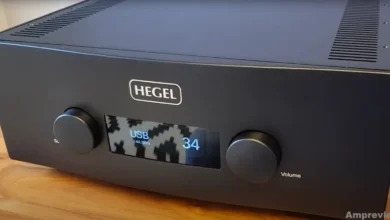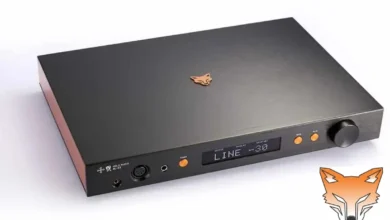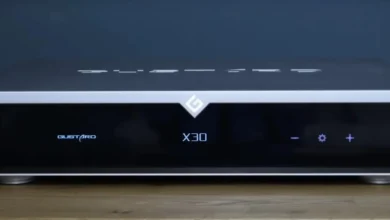

Elac EA101EQ-G – the traditional manufacturer from Kiel could hardly have called its new integrated amplifier more cryptic. The name behind the abbreviation EA is far more catchy: Element Amplifier. This already indicates that the EA101EQ-G is primarily aimed at hi-fi beginners or those switching over, which is also underlined by its sales price of 699 euros. In this price range, one buys mainly value-oriented – the focus is therefore on contemporary equipment, good sound quality and simple operation.
The Elac EA101EQ-G offers all of this – but it does it in an unusually clever and convincing way: the cute Elac does indeed have the potential to become the true successor to the legendary NAD 3020 from the early 80s of the last century and thus really shake up the hi-fi scene.
At the time, the NAD 3020 managed to do this in a way that is often referred to as “disruptive” in business English: it combined the basic audiophile amplifier knowledge of the previous transistor apprenticeship years in a simple but largely uncompromising circuit concept.
In addition to practical controls, it also had unusual features that were very useful for “insiders” – for example a pre-amplifier output for connecting external power amplifiers. With this concept, he triggered a revolution “from below” in the hi-fi market that had not existed before and became a legend.
The Elac EA101EQ-G could have a similar experience. However, he extends the strategy already proven with the NAD 3020 to elements that are at least as important today as connectivity, high-tech appeal, and design.
The Elac not only appeals to those who are already keen on hi-fi but also to younger customers who see high-quality music enjoyment less as a hobby and more as part of their lifestyle.
But no matter whether optically or technically: You can tell from the Elac EA101EQ-G in every respect that absolute professionals were at work here. Reason enough for LowBeats to present the smart amp from Kiel in detail below.
Elac EA101EQ-G: concept and features
First of all, the most important message of the Elac EA101EQ-G is: that music fits into the smallest hut. When it comes to space requirements, hardly larger than an iPad 2, it can be comfortably accommodated anywhere – for example in a compartment of the well-known and popular Ikea shelf and room divider Kallax, in which it also feels in good hands optically.
Since the Elac hardly gets more than lukewarm during operation, even under heavy use, the subject of ventilation also proves to be uncritical. A welcome side effect: there is space for a smartphone, iPod, remote control, or headphones on its non-slip surface, which can also be plugged directly into the front panel.
The Elac EA101EQ-G has already clearly defined its choice of environment – the urban single apartment, the weekend house, the student-shared room, and of course the home office.
For the typical room sizes here, its rated output power of around 2 x 80 watts at 4-ohm speakers should be completely sufficient – even when the atmosphere is a bit higher.
Digital sound sources such as streamers (e.g. the in-house Elac Discovery DS-S101-G already tested by LowBeats , set-top box, TV set, gaming console, CD player or computer) usually dominate in the scenarios just described .
The Elac EA101EQ-G also has the appropriate digital inputs for all of this equipment – as if there were two optical and one coaxial one according to the S/P-DIF standard and an asynchronous USB interface for direct connection of a laptop or desktop PC.
All digital inputs, including the optical ones, can process data streams of up to 24bit/192kHz and are therefore fully HiRes-compatible. But not only that. For example, if the set-top box provides a Dolby Digital signal at its S/P-DiF output, the Elac EA101EQ-G can also decode this.
Smartphones & Co., on the other hand, connect wirelessly to the Elac via the integrated, aptX-capable Bluetooth module. Of course, the compact amp from Kiel also allows analog sound sources to be connected, for which it has two unbalanced high-level inputs.
Cayin CS-55A Integrated Amplifier Review
Its connection field is completed by a subwoofer output: behind this there is an interesting feature that will be discussed later.
Elac EA101EQ-G: operation
There are four alternatives to choose from when it comes to operating the Elac EA101EQ-G. The included, easy-to-hold IR commander controls the range of functions required for ongoing operation, such as sound source selection and volume setting, but also conveniently the transport commands for devices that play wirelessly via Bluetooth.
If you don’t want to accumulate another IR transmitter on your side table, you can also have the Elac EA101EQ-G “learn” the keyboard commands that go with the respective operating steps from your favorite remote control. However, logically this only works if it is an IR commander and not a radio commander.
However, the Elac EA101EQ-G also uses the device itself in a rudimentary manner: Standby and program source selection are made via sensors, while a fairly full-running incremental encoder is responsible for volume adjustment.
At least you get feedback via a fairly bright OLED display, which communicates the current operating status in surprisingly modern writing.
An app of the same name, which is available free of charge for Android and iOS devices, is responsible for the rather extensive device setup of the Elac EA101EQ-G. This outsourcing was by no means out of sheer Appmania, but for several good reasons: First of all, the app also communicates with the Elac EA101EQ-G via Bluetooth, so that the playing Bluetooth signal source can conveniently also take over the remote control function for the amplifier at the same time.
There is another reason why the Elac developers housed the setup menu of the EA101EQ-G in an app. The compact Kieler has an extremely clever device that irons out weaknesses in the room acoustics if desired and can optionally also optimally adapt an external active subwoofer to the existing main loudspeakers.
At this tricky point, the acoustic know-how of the loudspeaker specialists from Kiel is revealed. Most AV receivers rely on more or less complex room calibration systems, which sometimes carry out rather questionable overall frequency response corrections based on measurements using microphones that have to be set up separately.
This is not the case with the system in the EA101EQ-G called Auto Blend & Calibrate (ABC). Elac deliberately limited itself to the frequency range below 200 Hertz – in this area, disturbing room resonances are mostly minimal, so that you can get decent results with appropriate (IIR) correction filters.
What is particularly clever about the ABC solution from Elac is that it uses the microphone built into the smartphone for the measurements. The following picture gallery shows how such a calibration process works with the help of the app.
Elac EA101EQ-G: Technology
In the age of compact, high-performance Class D switching amplifiers, it is no longer rocket science to accommodate what the EA101EQ-G has to offer in a housing of its dimensions.
However, the Elac is not that simple: Instead of the switching amplifiers that are prevalent in such compact devices, the EA101EQ-G relies on an amplifier specialty developed by the Canadian company Indigo a few years ago – the BASH principle – for reasons of sound.
The idea behind it is as simple as it is ingenious – it is not without reason that big names such as Philips and THX can be found in the corresponding patent specification.
For the speaker-driven power amplifier, BASH relies on the analog, sophisticated Class AB principle. However, this does not work as usual with a constant supply voltage: Rather, it is fed by a switching regulator that supplies an output voltage controlled by the input signal, which is proportional.
With this piggyback arrangement, BASH combines the advantages of analog and (quasi) digital operation – namely the well-known good sound properties with high efficiency and the associated low heating.
As a result, the large heat sinks required for conventional class AB amplifiers can be omitted, so that BASH amplifiers can be built just as compactly as switching amplifiers. The picture gallery below shows exactly how BASH works.
The small signal processing of the Elac EA101EQ-G is no less interesting for amplifier techies. Essentially, only one single component is responsible for this – namely the CS47024 from the American digital audio specialist Cirrus Logic.
This highly integrated “System-on-a-Chip” (SoC) solution combines, among other things, all A/D and D/A converters including sampling rate converters, the S/P-DIF interface controller and a flexibly programmable one 32-bit signal processor together with the associated data memory.
The hearing test Elac EA101EQ-G
It is not every day that you come across a BASH amplifier – moreover, as with the Elac as a full-range concept. So this time I was particularly curious about the listening test, for which I used both floor-standing loudspeakers such as the Canton Vento 886, and compact speakers such as the Elac Uni-Fi BS U5.
The Elac EA101EQ-G showed sound personality in a positive sense: With a sonorous timbre in the upper bass, the compact Kieler played beautifully “punchy” and grooved powerfully on dancefloor-filling tracks like Maceo Plex’s remix of Royksopp’s Sordid Affair.
He tended to paint warm sound images with a coat of paint that is commonly referred to as “analog”. The Elac reproduced the high-frequency range in a rather unobtrusive and finely defined manner.
The EA101EQ-G took a different sound direction than the Class D switching amplifiers usual in its class: these mostly play extremely transparent and airy at the top, but sometimes lack a little inner, tonal substance – in this respect the Elac EA101EQ-G showed a much more down-to-earth character.
Amplifier outputs of barely more than one watt per channel are completely sufficient for loudspeakers with a common degree of efficiency to produce hi-fi volumes in normal living rooms. In this respect, the 2 x 80-watt Elac EA101EQ-G can already sound an alarm in terms of dynamics – which was possible with the loudspeakers mentioned above, even in the rather subdued LowBeats listening room.
It is also clear, however, that the Elac should not necessarily be expected to have low-efficiency and/or power-sapping loudspeakers with 2-ohm impedance drops – then it will run out of power at higher levels, whereupon its protective circuit will put an end to the hustle and bustle.
Of course, I couldn’t resist trying out the app-controlled Auto Blend & Calibrate (ABC) setup during the listening tests. To check its flexibility, I chose an active subwoofer from another manufacturer to supplement the Elac Uni-Fi BS U5 – the T4000 from Teufel, intended for wall or floor mounting.
The sonic result was well worth listening to: ABC ensured a seamless transition between the subwoofer and the main loudspeakers and also set a strong filter in the 50 Hertz region to tame the room mode that was present here a little – the automatic system did exactly that what she should.
In terms of sound, there was still a lot more to get out of the speaker trio by manual adjustment with a lot of finesse, time and acoustic experience – the automatic, however, works faster, and smarter and also requires no acoustic knowledge.
Conclusion
One can argue whether such a small and also inexpensive device like the Elac EQ101EQ-G needs to be discussed in such detail as in the foregoing. My opinion on this: Absolutely – because on closer inspection you quickly realize that the EA101EQ-G is not just another compact amplifier, but the protagonist of a new generation of hi-fi devices.
Well thought-out in concept, clever in terms of technology, smart in appearance, and functional in practice – all this combined with very decent sound quality and, last but not least, a down-to-earth price.
The Elac EA101EQ-G makes conventional integrated amplifiers in the classic format look pretty old in the truest sense of the word. With the EA101EQ-G, Elac has achieved exactly what many other providers only dream of – namely to pick up young, music-loving customers. Congratulations to Kiel!
Elac EA101EQ-G Integrated Amplifier FAQs
Q1: What makes the EA101EQ-G unique?
A: This amplifier features an integrated Auto Blend and Calibrate (ABC) system that automatically optimizes the audio output based on the room’s acoustics and speaker placement. It also includes a high-performance DAC for digital audio playback.
Q2: What audio formats does the EA101EQ-G support?
A: It supports high-resolution audio formats up to 24-bit/192kHz, providing clear and detailed sound for digital music sources.
Q3: How many channels does the amplifier support?
A: The Elac EA101EQ-G is a two-channel stereo amplifier, making it suitable for powering a pair of speakers.
Q4: Does it have Bluetooth connectivity?
A: Yes, the EA101EQ-G features Bluetooth with aptX for high-quality wireless streaming from smartphones, tablets, and other Bluetooth-enabled devices.
Q5: How does the Auto Blend and Calibrate (ABC) system work?
A: The ABC system uses a microphone connected to your smartphone to measure the room’s acoustics. The app then adjusts the sound output to optimize bass integration and overall audio performance based on the room characteristics and speaker placement.
Q6: What kind of inputs does the EA101EQ-G have?
A: It offers a variety of inputs, including two analog RCA inputs, optical digital input, coaxial digital input, USB input, and Bluetooth for wireless streaming.
Q7: Can I use the EA101EQ-G to power passive subwoofers?
A: No, it is designed to power passive speakers, not subwoofers. However, it does feature a subwoofer output for connecting an active subwoofer.
Q8: Does it come with a remote control?
A: Yes, the EA101EQ-G includes a remote control for easy operation of the amplifier from a distance.
Q9: How do I update the firmware of the EA101EQ-G?
A: Firmware updates can be done via the Elac app. If an update is available, the app will guide you through the process to ensure the amplifier is up-to-date.
Pros and Cons of the Elac EA101EQ-G Integrated Amplifier
Pros:
- Compact Design:
- Auto Room Calibration (ABC System)
- High-Resolution Audio Support
- Multiple Input Options
- Bluetooth with aptX
- Good Power Output
- Built-in DAC
- User-Friendly App Control
Cons:
- No Multi-Room Audio Support:
- No Built-in Streaming Services












GIPHY App Key not set. Please check settings